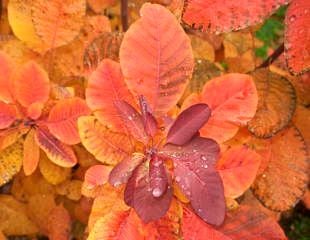

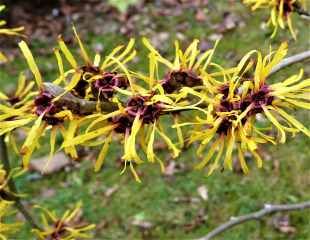
Shrubs and Plants for Autumn and winter Interest
It can be a long winter, and a tad gloomy.
One way to have a bit of cheer is by planting a shrub with colour and interest for autumn and winter. Besides shrubs with amazing autumn colour, there are also shrubs with bold variegated foliage, bright berries, winter flowers and winter scented shrubs. Winter shrubs with berries such as pyracanthas, provide excellent food for birds, especially Blackbirds and Thrushes, which are avid berry takers.
Many Acers have superb autumn colour and there are now so many varieties it's best to see them on display in a garden centre in autumn so you check out its autumn colours. As a broad rule of thumb, the green-leaved Acers produce the best autumn colour compared with the red leaved varieties.
If you are buying a shrub for autumn colour or winter scent, buy in the autumn or winter so you can check it out. For example, often Witch Hazel is described as scented. When I did the sniff test in the garden centre, I was disappointed in several, despite their effusive descriptions.
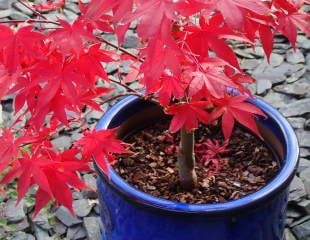
Best Acers for Autumn
Looking at autumn colour, as you may expect, we start with Acers. Bearing in mind, Acers are a large genus of 120 evergreen,deciduous shrubs and trees they do differ considerably, not least in height, anything from 20m to 3 metres. This means it's important to pick the right species of Acer. Illustrated is Acer palmatum which will grow to 10 meters so at some point it needs to come out of the container and into the ground.
If you are looking for autumn colour check out: Acer palmatum 'Osakazuki' and Acer palmatum Beni Maiko, both of which have a stunning red autumn colour. Acer palmatum var. dissectum 'Seiryu' has red/golden foliage, Acer palmatum var. dissectum Dissectum Atropurpureum Group, very red with dissected leaves growing to a large tree.

For smaller gardens is Acer palmatum ‘Little Princess’ which has yellow and red leaves in the autumn, and compact growth to around 1.5m. The RHS recommends Acer palmatum 'Shin-deshōjō' (AGM) which has lovely serrated leaves with strong red autumn colour, compact so ideal for a container up to 1.5 -2.5m. Although Acers are hardy, they do best in a sheltered spot, south or west facing.
But take care where you plant them, especially if in containers. The image left is of two Acers which were placed either side of our front door, which is north facing. There is morning sun and one got more sun that the other, and you can see its crispy, and dead. Hot sun will scorch their leaves especially in containers which tend to be hot growing spots.

Euonymus with good Autumn colour
Euonymus are tough, hardy shrubs which will tolerate most growing conditions and soils, which make them easy to grow. Illustrated is Euonymus alatus 'Compactus' also known as winged spindle / fire bush, is a fantastic Euonymus for autumn colour, striking bright red. This is a compact variety which will grow to around 1.5m making it ideal for the garden. The strong autumn foliage looks best in sun although E.alatus will grow in partial shade.
The deciduous varieties of Euonymus have excellent autumn colour. The following shrubs have the RHS AGM (Award of Garden Merit) which is always a good sign when selecting shrubs and plants.
E. alatus 'Fire Ball' E. carnosus E. europaeus 'Thornhayes' E. hamiltonianus 'Pink Delight' E. oxyphyllus 'Angyo Elegant' and also E. europaeus 'Red Cascade' and E. alatus ' Compactus'.
Autumn Crocus

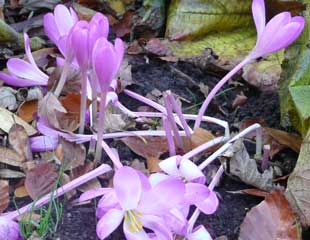
Another attractive autumn flowering bulb is Colchicum, the Autumn Crocus. It looks and behaves like a Crocus but it is in fact a member of the lily family. Like the spring Crocus, it looks good growing in a lawn and woodland settings. They bloom in shades of mauve, pink and white on leafless stems.
Plant in late summer, August time and this bulb needs to be planted 3x its depth, around 10 cm deep 15 cm apart. Bulbs are poisonous, so protect yourself by wearing gloves. Left undisturbed, Colchicum will spread and naturalise.They will grow in full sun or dappled shade and once planted, are maintenance free.

Chinese Lantern Plant,
This is Physalis alkekengi, common name Chinese Lantern Plant, which makes an attractive autumn display with its bright red lanterns.
It is easy to grow, arguably too easy, as many consider it invasive. To contain it (as it is in the image) grow in a small border on its own, in a pot or like mint, grown in a container sunk into the soil. It spreads its roots the same way as mint, but in the right place it's an unusual autumn plant and the "lanterns" make lovely autumn indoor decorations. Cut the stems, remove leaves and hang up to dry.
Plant Physalis in sun or partial shade where you can keep it within its boundaries.
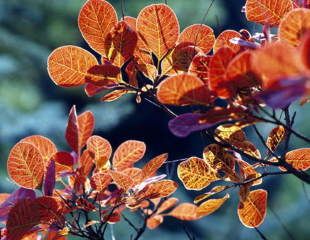
Cotinus have strong autumn colour
Cotinus coggygria, in its different varieties, has lovely autumn colour. Illustrated is Cotinus 'Flame' which is a green-leaved variety which becomes a bold orange colour in the autumn and is reputed to be the best Cotinus for autumn colour. Also attractive is C. 'Royal Purple' the colour of the purple leaves intensify in autumn.
Cotinus is an easy to grow deciduous shrub, tolerant of most conditions. It is quite a large shrub which needs space.
Cotinus is easy to grow and is a good choice for autumn colour.

Autumn flowering Camellia sasanqua
We always think of camellia as spring flowering, which predominantly is the case but there are some lovely autumn flowering camellia which will bloom from October until December.
Illustrated is C.sasanqua 'Maiden's blush' which has light pink flowers which are delicately scented.
More information about how to plant, grow and prune Camellia sasanqua.
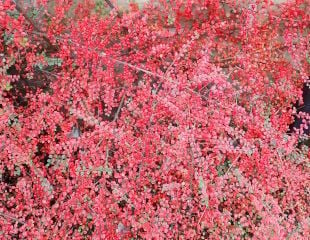
Pyracanthus
Pyracantha is also known as Firethorn and looking at its autumn colour, its easy to see why, with really bright red autumn leaves. Illustrated is pyracantha horizontalis, which, as the name suggests, tends to grow outwards more than up.
In the spring and late summer it has small white flowers which bees go mad for the whole bush hums and buzzes, followed by berries for the birds and then a strong autumn colour. It's hardy, and easy to grow, grow anywhere shrub. View some varieties on Crocus (affiliate link)
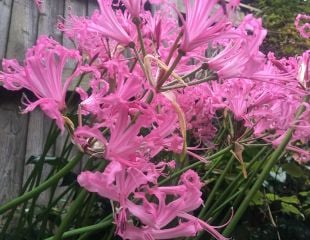
Nerines
Nerines are a clump forming bulb which flower in September and October. The most commonly grown and most hardy variety H5, illustrated, is N. bowdenii.
Normally we plant bulbs 3x their depth, but not Nerines, which have specific planting requirements. Nerines flower best if grown in a sheltered sunny spot in free draining soil. Nerines do not flower well in shady areas. To get Nerines to flower in autumn, they are best planted in early spring around April and May.
Plant the bulb 10 cm apart and with the tip is just showing above ground and mulch with a covering of grit. Nerines can be grown in containers, when you can plant a bit closer together but in the same way with the tip showing and a grit/gravel mulch.
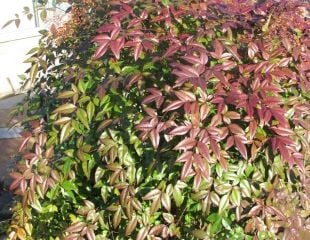
Nandina domestica
Nandina domestica, also known as the heavenly bamboo, has good autumn colour and is a shrub with all round interest. "Obsessed" and "Firepower" are varieties known for their autumn colour.
Nandina, when planted in good growing conditions, will produce flowers in the spring, usually white, followed by berries and autumn colour.
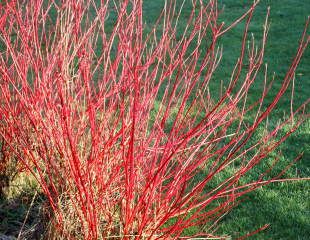
Cornus bold winter stems
There are many varieties of Cornus, some of which have bold coloured winter stems. Illustrated is C. alba Siberica with bright red stems in winter, which look very attractive. There is also a variety with yellow stems called Cornus sericea 'Flaviramea' It is a deciduous shrub and when the leaves fall off, it displays the brightly coloured stems of red, orange or yellow depending on the variety. The stems look fabulous back lit by low winter sun. Cornus is reliable, tolerant of wet conditions and partial shade.
Cornus are easy to grow but need annual pruning to produce the best winter colour, ideally coppicing. This video shows before and after how to coppice Cornus..
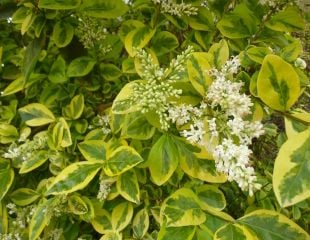
Striking foliage
Another Euonymus, this is E. fortunei 'Emerald 'n Gold' quite different from those described above. Euonymus fortunei are evergreen shrubs with bold, variegated foliage and this image really does not do the shrub justice.
In the gloomy winter days, the variegated foliage really stands out and makes a bold, bright splash of colour.
Euonymus is an easy to grow, tough, plant anywhere fully hardy shrub which is maintenance free.
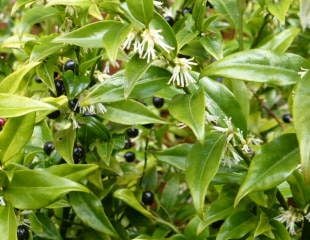
Sarococca common name sweet box
Sarcococca is known as sweet box because of its lovely, strongly scented, white winter flowers. It will fill an area with scent so welcome in the dark winter months.
Sarcococca is easy to grow, even in shade and dense shade and will tolerate neglect. many varieties are low growing ideal for hedges and edging. It makes a lovely scented addition to hedging around a front door or a winter bedding container.
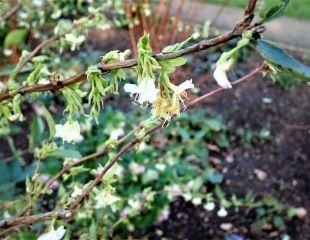
The best winter scent of all
This doesn't look much of a shrub, but without doubt it has the loveliest winter scent of all. It is Lonicera fragrantissim, Winter flowering Honeysuckle and it really has the sweetest of perfume. I visit a particular garden in winter just to enjoy it. In my next garden, I will plant one near a path where I can make daily trips to smell it.
It flowers mid December to March - tips on how to grow and prune Winter flowering Honeysuckle.
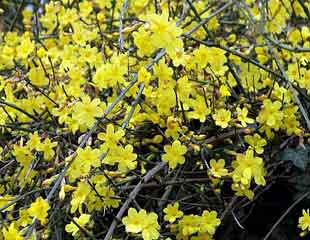
Bright yellow flowers
Winter flowering Jasmine, jasminum nudiflora is a deciduous climbing plant with bright yellow flowers in winter. This variety of Jasmine is not scented. It is fully hardy and makes up for the lack of scent with its luminous bright yellow flowers which appear ahead of the leaves.
It is a very colourful sight when in full flower, bright against the winter murk.
Over time, it can get into a bit of tangle which is easily remedied by being pruned back into a tidy shape. How to grow and prune Winter Jasmine.
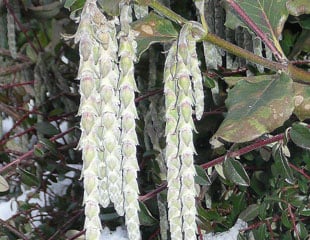
Great winter tassels
Garrya elliptica is an evergreen shrub, which is also known as the silk tassel bush, and it's easy to see why.
Long tassels, which look striking, festoon it from December onwards, depending on the variety.
Not all varieties are fully hardy and it does need a sheltered spot - growing advice about Garrya elliptica.
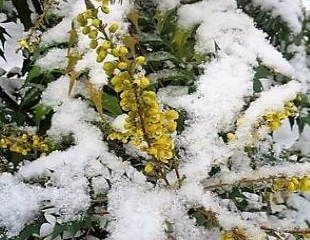
Winter flowering and scented
Mahonia is an evergreen shrub which flowers in the winter.
Illustrated left and above in the centre, it is an easy to grow shrub, flowering early in the year during the winter, predominantly in January.
Mahonia has a few scented varieties, like M. Charity and M. 'Lionel Fortescue'. Charity, and M. 'Lionel Fortescue'. They are a tall shrub, with sharp spines often planted on a boundary to deter intruders, and make a colourful hedge. Tips and ideas on growing Mahonia.
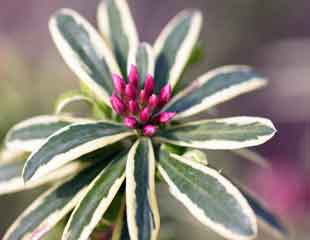
Scented Daphne
Daphnes have strongly scented flowers which bloom in winter and some varieties in spring.
There are both evergreen and deciduous varieties of Daphne and some, as illustrated, have variegated leaves. All have powerfully, sweetly scented flowers.
Daphne is not easy to grow and requires precise growing conditions.

Hamamelis spidery scented flowers
Grown for spidery flowers with winter scent Hamamelis, common name Witch Hazel, is more of a small tree than a shrub. It is deciduous and the flowers form ahead of the leaves (like forsythia). The flowers are usually red, orange, yellow or mauve, illustrated is Hamamelis vernalis Amethyst. If you are planting for scent, I recommend buying in the winter and smelling the shrubs first. Not all Hamamelis are equal in scent terms.
Hamamelis are slow growing and look good in a woodland setting or as a solitary tree as they tend to get a bit lost if planted in a mixed setting. More illustrations and growing advice about Hamamelis including how to pick a scented variety.
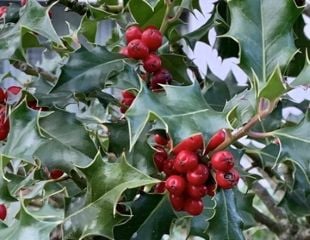
Holly and its berries
Nothing beats the sight of a holly bush laden with berries, the essence of an English winter.
Holly is evergreen, and slow growing, although most do get quite tall, eventually. Hollies are fully hardy, easy to grow shrub, and will grow in partial shade. Since Holly is grown for its lovely berries, it is important to know you have to have both sexes to get the berries and the names are no help at all. For example "Silver Milkmaid" is male. More about growing Hollies and getting berries.
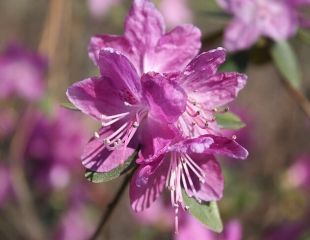
Winter flowering Rhododendron
This is Rhododendron dauricum, (credit image Wiki Anneli Salo) 'Mid- Winter' as the name suggests is a winter flowering Rhododendron and this variety has the RHS garden merit award. It is fully hardy, grows only in acid soil and prefers dappled shade. It makes a really good winter interest shrub flowering in December and January.

Skimmia japonica
Skimmia is a group of shade loving, evergreen spring flowering shrubs. Skimmia are compact growing to around 1.5m and is ideal for a smaller garden and growing in containers. All Skimmia produce flowers, only female Skimmia produces berries, which requires a male plant nearby.
Skimmia is fully hardy, low maintenance and idea for a shady border.
More about growing Skimmia and how to get the best flowers and berries.
